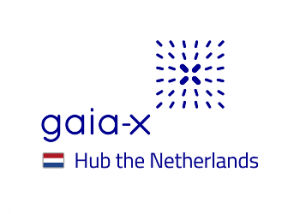This article was originally created by the Centre of Excellence for Data Sharing and Cloud and can be found here.
To contribute to the Structura-X project of Gaia-X, the Dutch Gaia-X hub, TNO, BIT, Intermax, Info Support, SURF and AMS-IX are conducting tests around cloud federation and portability in a national Gaia-X test environment. During one of our most recent Community Meetings, Erik Langius, Senior Integrator & Project Manager at TNO, elaborated on the need for a European federated cloud infrastructure that enables organisations to freely shift their data across several cloud providers.
Cloud market is largely dominated by hyperscalers creating lock-in effects
The volume of data is increasing exponentially. A cloud infrastructure is key for applications that process and access large amounts of data. “Ideally, this cloud infrastructure is federated, which enables organisations to freely choose from multiple cloud providers to store and process their data. Whether this is from a cost, data privacy or sustainability perspective.” Erik says. “However, for data processing, Europe highly depends on the cloud infrastructure provided by American hyperscalers such as Amazon, Google and Microsoft. As a result, an estimated 92% of data produced in the Western world is currently stored in the USA and only 4% in Europe. Despite the fact that cloud infrastructure is the core of our digital society, European cloud providers still only play a small role.”
This has to do with both financial and technical barriers, Erik says. “It is often initially free to store data, but if a company chooses to transfer that data to another provider, high costs are involved. Moving large data sets to another cloud infrastructure can sometimes cost hundreds of thousands of euros. Not only are the costs a challenge, it also requires a significant engineering effort to allow data to flow between different cloud infrastructures. In short, the current cloud market is not well structured.” This is also the conclusion of the ACM, which conducted a market study on cloud services last year. It says that ‘after the first moment of choice, there may be vendor lock-in, meaning users are locked into the chosen provider for a long time.’ According to Erik, it is imperative that cloud providers should make it easier for data to move from one cloud infrastructure to another. “The current ecosystem is still far too closed. Hyperscalers dominate the market and it is difficult for small cloud providers to enter. There is no level playing field. In fact, the turnover of hyperscalers is only increasing, whereas that of European cloud providers is declining.”
Cloud portability is a key condition to offer ‘sovereign’ cloud services in Europe
With new European legislation in the form of the Data Act, Europe wants to take steps towards a more open cloud ecosystem. It states that cloud portability is a key condition to offer cloud services in Europe. Erik: “You could compare this with the telecom law from years ago. Today, it is possible to call someone who has an iPhone with an Android phone, while you both have a different telecom provider. And if you want to switch providers, you can simply keep your number. The same simplicity must also be achieved in the cloud market, where end users regain control over where to store their data and when. Whether that is with a hyperscaler or with a small local cloud provider. It is therefore a misconception that Europe has set itself the goal of creating a new competitive hyperscaler. Instead, it wants to create a virtual hyperscaler that uses existing infrastructures and the high data center capacity within European borders. This decentralised setup becomes even more important as we see a move to the edge in which data should be processed closer to the source instead of in a central cloud.”
Structura-X aims to achieve interoperability of cloud services
Within Gaia-X’s European project Structura-X, a group of independent cloud service providers is working on common certification and quality marks to achieve interoperability of cloud services. This creates more freedom of choice for customers of infrastructure and platform services and creates more digital sovereignty in the cloud landscape. The Netherlands is also contributing by building a national Gaia-X test environment. With this environment, cloud service providers can investigate how they can comply with the European cloud standards, specifications and rules of Gaia-X. Erik: “In this first phase, the parties involved use the test setup to investigate whether data and calculations can be moved from cloud provider to cloud provider. In addition, it is investigated to what extent the capacities of different cloud providers can be combined with each other. In subsequent phases, the Dutch test environment will be linked to Italian, German and Belgian test environments to implement cloud federation principles across national borders. By setting up this European test infrastructure, cloud providers can offer Gaia-X compliant cloud services in an open ecosystem.”




